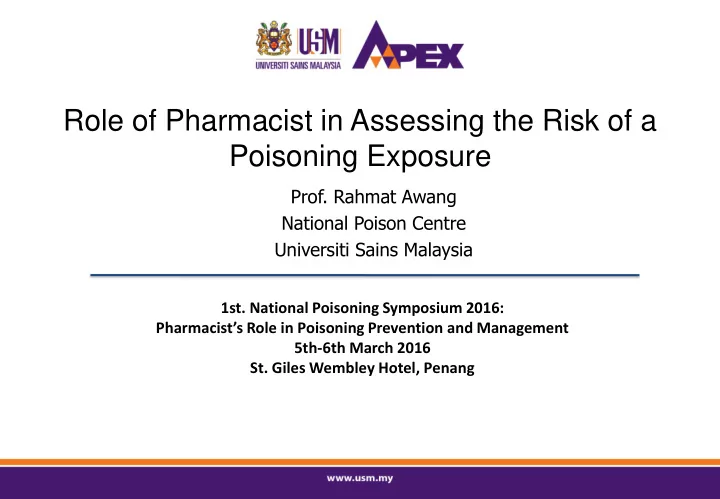

Role of Pharmacist in Assessing the Risk of a Poisoning Exposure Prof. Rahmat Awang National Poison Centre Universiti Sains Malaysia 1st. National Poisoning Symposium 2016: Pharmacist’s Role in Poisoning Prevention and Management 5th-6th March 2016 St. Giles Wembley Hotel, Penang
What we pharmacists do in the Poisons Information Centre A specialized unit providing information and advise on poisoning to both health care professional and the general public. Main source of toxicological information in the country Toll-free telephone access on a 24 hour basis, 7 days a week
Information Resource for Drugs and Poisons Main source of toxicological information in the country – Files on pharmaceuticals, chemicals, plants and animals. – Collection of data on clinical cases and inquiries. – Books, publications, journals – Bibliographic Indexes & Computerized Databases: • Medline, Toxline • Micromedex, Poisindex, Toxinz, HyperTox • Adverse Reactions • Current Contents • Toxicology abstracts • Excerpta Medica • Index Medicus – Publications Of International Organizations eg. WHO / IPCS, FAO, ILO, UNEP, IARC
Assistance given by PIC in a poisoning exposure Identification of the poison ? What is to be expected from the exposure ? What would be the best approach for managing the case? Whether antidotes are available AND how it should be used ? Whether there are long-term effects ?
PIC assists health professionals in assessing and recommending actions to be taken in a poisoning exposure: • To determine whether patient is in: – No danger • Follow up calls needed if admission not recommended – Potential danger • Evaluate carefully and a suitable observation period in the hospital is required – Immediate danger • Emergency first aid • Emergency stabilization • Follow-up treatment
Background information: WH questions Who?: Caller (Physician, Nurse, Public health) Patient (age, weight, sex, occupation, underlying disease, concomitant drugs) What? Type of poisoning product (Chemical name, generic name, brand name, Picture, Package, colour, odor) to identify the poisoning Amount of exposure • Where? - Place of poisoning incident: Home, workplace, enclosed public places - Place where poison was obtained / bought: in house or industrial? (to identify concentration of the products)
Background information: WH questions • When? - onset of symptoms, time of ingestion (to identify/confirm of poison product, to predict severity and, to identify management) • How? - route of exposure, symptoms (to identify management), Laboratory (units of volume) • Why? - Intentional, Unintentional (to find the prevention)
Assessing risk of poisoning – Summarize the information • Assess the patient’s condition – WH question? – Acute, Chronic, Acute on chronic – Triage risk assessment: type of poisoning, quantity, symptom, laboratory, time since ingestion, etc. • The treatment and management prior to call and its outcome • Quantitative assessment – estimated dose of exposure, range of toxicity – The quality of information received
Risk Assessment Approach Triage (deciding the urgency of treatment): No danger Follow up calls needed if admission not recommended Potential danger Evaluate carefully and a suitable observation period in the hospital is required Immediate danger Emergency first aid Emergency stabilization
Risk Assessment Approach Alternative approach of classifying the risk of poisoning: No risk Minor risk Moderate risk High risk Take into account: Established poisoning * Agent toxicity * Dose of exposure * Time of ingestion * Current clinical status * Individual patient factors
Poisoning Severity Score • A standardized scale for grading the severity of poisoning allows qualitative evaluation of morbidity caused by poisoning, better identification of real risks and comparability of data. • Take into account only the observed clinical symptoms and signs • Do not estimate risks or hazards on the basis of parameters such as amounts ingested or serum/plasma concentrations
Poisoning Severity Grade • None (0): No symptoms or signs related to poisoning • Minor (1): Mild, transient and spontaneously resolving symptoms • Moderate (2): Pronounced or prolonged symptoms • Severe (3): Severe or life-threatening symptoms • Fatal (4): Death
http://www.who.int/ipcs/poisons/pss.pdf
Thank You Transforming Higher Education For A Sustainable Tomorrow
Recommend
More recommend